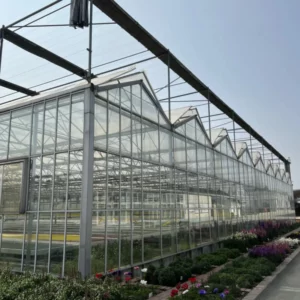Glass greenhouses and hydroponic systems serve different purposes within the realm of controlled environment agriculture, but they can also complement each other.
Here are the primary differences between a glass greenhouse and hydroponic systems:
- Purpose:
- Glass Greenhouse: A glass greenhouse is primarily designed to provide a controlled environment for plant cultivation, offering protection from external elements such as weather, pests, and diseases. It utilizes natural sunlight for photosynthesis and typically incorporates traditional soil-based growing methods.
- Hydroponic Systems: Hydroponic systems focus on growing plants in a soilless medium, with nutrient-rich water solutions providing essential nutrients directly to the plant roots. These systems can be employed both indoors and outdoors and are often used for maximizing space efficiency and crop yield.
- Growing Medium:
- Glass Greenhouse: Plants in a glass greenhouse are typically grown in soil or soilless media such as potting mix or coco coir. The soil provides support, stability, and some nutrient content to the plants.
- Hydroponic Systems: Hydroponic systems use a soilless growing medium, such as perlite, rockwool, coconut coir, or hydroton (expanded clay pellets). The plants receive all essential nutrients directly from the nutrient solution, which is continuously or periodically circulated through the root zone.
- Nutrient Delivery:
- Glass Greenhouse: Nutrients for plants in a glass greenhouse primarily come from the soil or growing medium. Although supplemental fertilizers may be added to the soil, nutrient availability is largely dependent on soil composition and microbial activity.
- Hydroponic Systems: Nutrients in hydroponic systems are delivered directly to the plant roots through the circulating nutrient solution. Growers have precise control over the nutrient composition and concentration, China Glass Greenhouse supplier allowing for optimal plant nutrition and growth.
- Water Usage:
- Glass Greenhouse: Water usage in a glass greenhouse depends on factors such as plant type, environmental conditions, and soil moisture levels. Water is typically applied to the soil surface and absorbed by the plant roots.
- Hydroponic Systems: Hydroponic systems are known for their efficient water usage, as water is recirculated within the system and absorbed directly by the plant roots. Water loss due to evaporation and runoff is minimized, making hydroponics a sustainable option, especially in regions with water scarcity.
- Crop Diversity and Growth Rate:
- Glass Greenhouse: Glass greenhouses accommodate a wide range of crops, including fruits, vegetables, flowers, and ornamental plants. The growth rate and yield of plants in a glass greenhouse may vary depending on factors such as light intensity, temperature, and soil quality.
- Hydroponic Systems: Hydroponic systems can support rapid plant growth and high yields due to the direct delivery of nutrients to the roots. They are well-suited for growing leafy greens, herbs, strawberries, tomatoes, cucumbers, and other crops with high water and nutrient requirements.
In summary, while glass greenhouses and hydroponic systems differ in their growing methods and nutrient delivery mechanisms, they both offer opportunities for controlled environment agriculture and can be used in conjunction to maximize productivity and crop quality.

What are the differences between Glass Greenhouse and other hydroponic systems?
